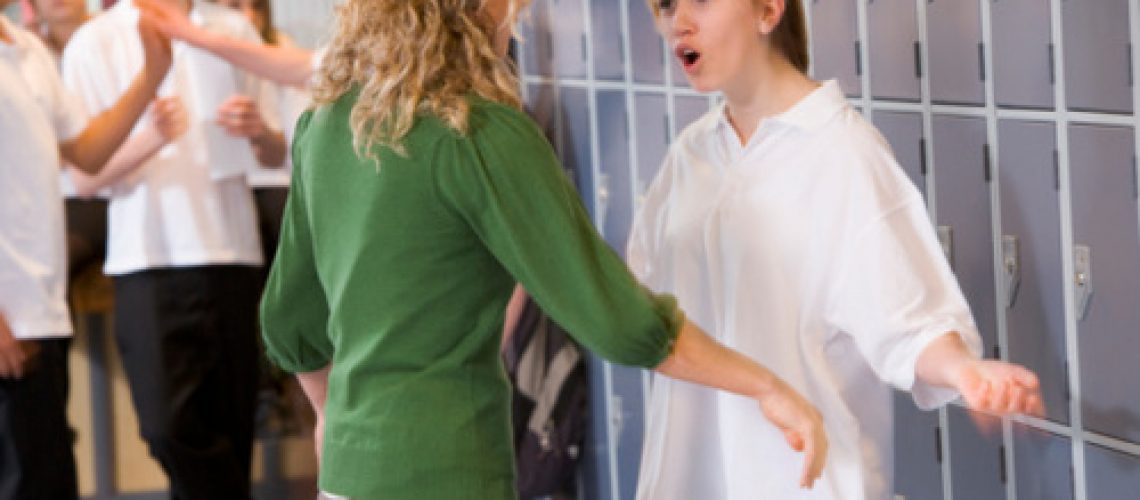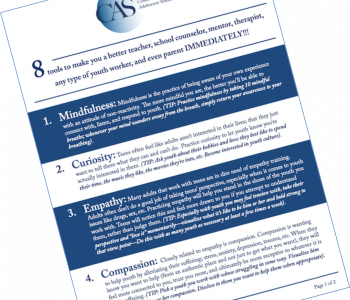

Sam Himelstein, PhD
Sam Himelstein is the founder and CEO of the Center for Adolescent Studies, Inc. He is passionate about working with youth and training the professionals that serve them.
Why Setting Boundaries Is Critical To Healthy Relationships with Teens
As I approach facilitating the fourth installment of the Mindfulness-Based Substance Abuse Treatment (MBSAT) Curriculum Certification this weekend, I find myself contemplating what some of the most important aspects of working with teens are. Being authentic, present, compassionate, and intentionally fostering a genuine relationship are of critical importance, as I’ve written about in other posts. However, one of the issues I hear over and over again from the folks I train (teachers, therapists, probation professionals, etc.) is what to do when boundaries are tested. I often ask large groups of people at conferences who work with youth (often sarcastically) “Do the youth you work with ever test your boundaries?” and of course almost everyone raises their hand. As teens get to know themselves, and you, they often find ways to test boundaries. What most professionals find difficult is how to create meaningful relationships, but also maintain strong, healthy boundaries. Often, the two paradigms aren’t skillfully practiced in the same individual. Many strict teachers, therapists, group home staff, etc. want to “put their foots down,” “hold their own” or “not get walked on like a mat.” On the other hand, professionals who create relationships without boundaries are deemed “softies,” “unprofessional,” and many other terms that suggest they either don’t have the skill-set to confront youth or are scared that doing so would hurt the meaningful relationships they’ve created. The truth is that both are needed: building authentic and meaningful connections is imperative to foster positive outcomes. But doing so without healthy boundaries will only inhibit the youth. We can learn and practice setting boundaries in healthy, mindful, and compassionate ways that contribute to building the relationship (i.e., a healthy adult-adolescent model).
Let me take a step back and describe why healthy boundaries are important in the first place. The bottom line is that healthy boundaries ultimately make you a “safe” adult. Especially if you work with marginalized youth dealing with poverty, gang violence, drugs in the community, etc. (and even if you do not), the youth you encounter will have undoubtedly had some relationships with adults that were manipulative. These might be older friends, teachers, relatives, and sometimes parents. When adults manipulate youth, their paradigm shifts into distrust of adults (let alone people in general). When we set boundaries, it may initially upset the youth, but over time they will respect you more because they’ll know you’re a safe relationship—someone they can trust; someone they can go to for guidance and help.
The key though, is that when we do set those boundaries, they are done skillfully in the best interest of the youth and not from a reactive place (at least that’s the goal).
How do we do set healthy boundaries?
The first step is to manage the emotions that arise when a boundary is tested. If someone in your classroom is acting goofy and you need to get on with your lecture, notice what arises in you first. Maybe it’s frustration, or anger, or even exhaustion. Use practices like mindfulness that enhance your self-awareness of the moment so you can make conscious decisions about what to do next. One thing you might do is take a deep belly breath or two. It may seem simple, or even corny at times, but actually breathing deeply will activate your parasympathetic nervous system and the relaxation response. Even if you relax just slightly more, you’ll be that much more able to engage and set the boundary skillfully.
Next, rather than making a demand (i.e., “you need to stop being goofy right now!”), ask a question. Asking a question helps youth to actually think about what you’re asking (i.e., they’ll go to a cognitive place) and you’ll encounter much less resistance. Making a demand will most often create more resistance. If folks in your group are engaging in side-talk, a simple question like,“what are you two talking about?” with a genuine interest can sometimes completely derail the side talk. The question can be specifically about the boundary tested “How do you think my experience is when you’re talking?” or not “what’s going on with you?” We just want to get them thinking rather than reacting (to a demand). The key is to ask these questions with a non-attacking respectful tone and to engage the youth in a brief side conversation momentarily prior to asking them to re-engage the lecture/discussion material you’re trying to present. That’s easier said then done, especially if you’re frustrated. That’s why mindfulness and other self-awareness practices are extremely important and the first step.
Once you’ve asked the question, then respectfully clarify the boundary: “What are you two talking about? … [Be genuinely interested, let them answer, and momentarily engage the side conversation, then continue with setting the boundary] … it’s really difficult for me to present this lecture when you’re talking. Could you hold the conversation off for a little longer while I present this lecture? I really want to know what you think and know you’ll have something to contribute to the discussion.”
One other activity I would encourage is to write down all the “rules” (I like to call them agreements, but that’s for another blog post) you have in your classroom, therapy room, or whatever your context for working with youth. Things like no side-talking, respect, no put-downs, and other basic agreements should be contemplated and written down. Maybe you don’t want youth on their cell phones in your class? Maybe you don’t have that problem because you run a therapy group in an inpatient drug treatment center. The idea is to think ahead about all the boundaries that could get tested. If you think about them ahead of time, and what you’d say/do when such boundaries get tested, you’ll be much better equipped to set those healthy boundaries when needed, in a skillful, relational way. This ultimately will help you build authentic relationships with the youth you work with.
In sum, 1) manage any emotions that arise when a boundary is tested, 2) start with a question, and 3) clarify your boundary. This will ultimately help you become a safe relationship, which precludes a true authentic relationship with adolescents.
Related posts on healthy and effective boundaries when working with youth:
Four Dos and Don’ts for Setting Effective Boundaries with Youth
4 Qualities That Lead to Interpersonal Connection and Safety With Youth
6 Tips for Building Authentic Relationships with Adolescents
What Can I Do if a Youth Asks Me for Personal Information?
For ongoing training and development on authenticity, effective boundaries and building authentic relationships with those you work with, check out our FREE self-paced training and live practice sessions on Zoom every month by joining the Resilience Training Community!

